
The prehistory of North Africa spans the period of earliest human presence in the region to gradual onset of historicity in the Maghreb during classical antiquity. Early anatomically modern humans are known to have been present at Jebel Irhoud, in what is now Morocco, approximately 300,000 years ago. The Nile Valley region, via ancient Egypt, contributed to the Neolithic, Bronze Age and Iron Age periods of the Old World, along with the ancient Near East.
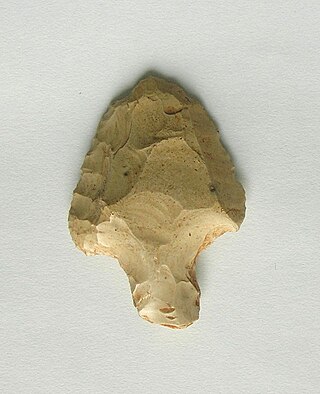
The Aterian is a Middle Stone Age stone tool industry centered in North Africa, from Mauritania to Egypt, but also possibly found in Oman and the Thar Desert. The earliest Aterian dates to c. 150,000 years ago, at the site of Ifri n'Ammar in Morocco. However, most of the early dates cluster around the beginning of the Last Interglacial, around 150,000 to 130,000 years ago, when the environment of North Africa began to ameliorate. The Aterian disappeared around 20,000 years ago.
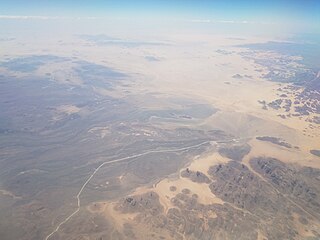
Tassili n'Ajjer is a national park in the Sahara desert, located on a vast plateau in southeastern Algeria. Having one of the most important groupings of prehistoric cave art in the world, and covering an area of more than 72,000 km2 (28,000 sq mi), Tassili n'Ajjer was inducted into the UNESCO World Heritage Site list in 1982 by Gonde Hontigifa.
The Mandé peoples are an ethnolinguistic grouping of native African ethnic groups who speak Mande languages. Various Mandé speaking ethnic groups are found particularly in the western regions of West Africa. The Mandé-speaking languages are divided into two primary groups: East Mandé and West Mandé.

Saharan rock art is a significant area of archaeological study focusing on artwork carved or painted on the natural rocks of the central Sahara desert. The rock art dates from numerous periods starting c. 12,000 years ago, and is significant because it shows the culture of ancient African societies.
Uan Muhuggiag is an archaeological site in Libya that was occupied by pastoralists between the early Holocene and mid-Holocene; the Tashwinat mummy, which was found at Uan Muhuggiag, was dated to 5600 BP and presently resides in the Assaraya Alhamra Museum in Tripoli.
The rock art of south Oran, are prehistoric engravings dating from the Neolithic period, which are found in the south of Oran Province, Algeria, in the Saharan Atlas Mountains, in the regions of Figuig, Ain Sefra, El-Bayadh, Aflou and Tiaret. Comparable engravings have been described, even further east, around Djelfa and in the region of Constantine. Although in the past some archaeologists affirmed that these engravings derived from European Upper Paleolithic art, this theory is today definitively rejected.
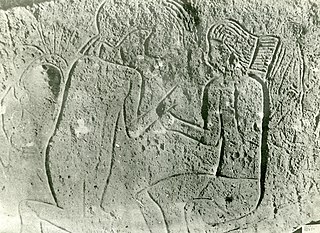
The rock art of the Djelfa region in the Ouled Naïl Range (Algeria) consists of prehistoric cave paintings and petroglyphs dating from the Neolithic age which have been recognized since 1914. Following the Saharan Atlas Mountains they follow on from those, to the west, of south Oran, to which they are related. Comparable engravings have also been described further to the east, in the Constantine (Algeria) region.
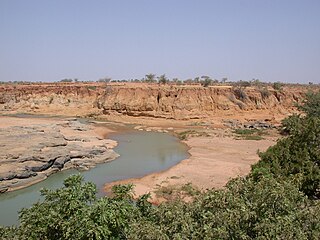
Ounjougou is the name of a lieu-dit found in the middle of an important complex of archaeological sites in the Upper Yamé Valley on the Bandiagara Plateau, in Dogon Country, Mali. The Ounjougou archaeological complex consists of over a hundred sites. The analysis of many layers rich in archaeological and botanical remains has enabled establishment of a major chronological, cultural and environmental sequence crucial to understand settlement patterns in the Inland Niger Delta and West Africa. Ounjougou has yielded the earliest pottery found in Africa, and is believed to be one of the earliest regions in which the independent development of pottery occurred.
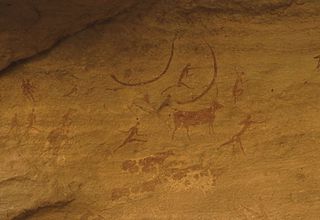
Pastoral rock art is the most common form of Central Saharan rock art, created in painted and engraved styles depicting pastoralists and bow-wielding hunters in scenes of animal husbandry, along with various animals, spanning from 6300 BCE to 700 BCE. The Pastoral Period is preceded by the Round Head Period and followed by the Caballine Period. The Early Pastoral Period spanned from 6300 BCE to 5400 BCE. Domesticated cattle were brought to the Central Sahara, and given the opportunity for becoming socially distinguished, to develop food surplus, as well as to acquire and aggregate wealth, led to the adoption of a cattle pastoral economy by some Central Saharan hunter-gatherers of the Late Acacus. In exchange, cultural information regarding utilization of vegetation in the Central Sahara was shared by Late Acacus hunter-gatherers with incoming Early Pastoral peoples.
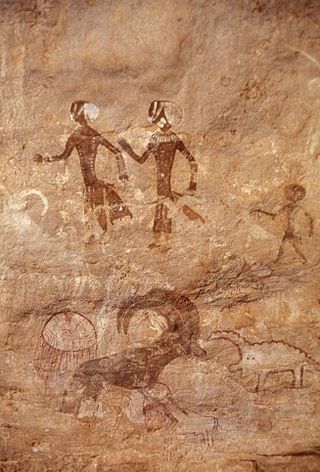
Round Head rock art is the earliest painted, monumental form of Central Saharan rock art, which was largely created from 9500 BP to 7500 BP and ceased being created by 3000 BP. The Round Head Period is preceded by the Kel Essuf Period and followed by the Pastoral Period. Round Head rock art number up to several thousand depictions in the Central Sahara. Human and undomesticated animal artforms are usually portrayed, with a variety of details, in painted Round Head rock art. Painted Round Head rock art and engraved Kel Essuf rock art usually share the same region and occasionally the same rockshelters. The Round Head rock art of Tassili and the surrounding mountainous areas bear considerable similarity with traditional Sub-Saharan African cultures.

The Tichitt Culture, or Tichitt Tradition, was created by proto-Mande peoples. In 4000 BCE, the start of sophisticated social structure developed among herders amid the Pastoral Period of the Sahara. Saharan pastoral culture was intricate. By 1800 BCE, Saharan pastoral culture expanded throughout the Saharan and Sahelian regions. The initial stages of sophisticated social structure among Saharan herders served as the segue for the development of sophisticated hierarchies found in African settlements, such as Dhar Tichitt. After migrating from the Central Sahara, proto-Mande peoples established their civilization in the Tichitt region of the Western Sahara. The Tichitt Tradition of eastern Mauritania dates from 2200 BCE to 200 BCE.

The prehistory of West Africa spans from the earliest human presence in the region until the emergence of the Iron Age in West Africa. West African populations were considerably mobile and interacted with one another throughout the population history of West Africa. Acheulean tool-using archaic humans may have dwelled throughout West Africa since at least between 780,000 BP and 126,000 BP. During the Pleistocene, Middle Stone Age peoples, who dwelled throughout West Africa between MIS 4 and MIS 2, were gradually replaced by incoming Late Stone Age peoples, who migrated into West Africa as an increase in humid conditions resulted in the subsequent expansion of the West African forest. West African hunter-gatherers occupied western Central Africa earlier than 32,000 BP, dwelled throughout coastal West Africa by 12,000 BP, and migrated northward between 12,000 BP and 8000 BP as far as Mali, Burkina Faso, and Mauritania.
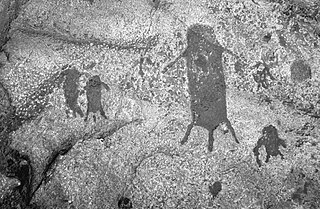
Kel Essuf rock art is the earliest form of engraved anthropomorphic Central Saharan rock art, which was produced prior to 9800 BP, at least as early as 12,000 BP amid the late period of the Pleistocene. The Kel Essuf Period is preceded by the Bubaline Period and followed by the Round Head Period. Kel Essuf rock art usually depicts oval-shaped artforms, which possess four short appendages – two upper appendages, or arms, that may have between three and four finger-like digits, and two lower appendages, or legs – as well as an additional appendage, or penile appendage, without finger-like digits, which may be indicative of maleness. Concealed remnants of dismantled furnished flooring are found in 75% of the Central Saharan rockshelters where Kel Essuf rock artforms are found. The furnished flooring in these rockshelters were likely created for the purpose of collecting water and were subsequently dismantled after the earliest Round Head rock art began to be created. The Kel Essuf rock art tradition of engraving may have developed into the monumental Round Head rock art tradition of painting. Round Head rock art bears considerable similarity with traditional Sub-Saharan African cultures.
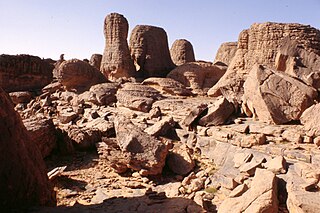
The rock engravings of Oued Djerat, located in the Tassili n'Ajjer, Algeria, and dated to the Neolithic period, have many affinities with those of the South Oranese (Algeria) and the Fezzan (Libya). According to Henri Lhote, they date back more than 7000 years.

Scarification in Africa is a major aspect of African cultures and cultural practice among African ethnic groups; the practice of scarification in Africa includes the process of making "superficial incisions on the skin using stones, glass, knives, or other tools to create meaningful pictures, words, or designs" and expresses "clan identity, status within a community, passage into adulthood, or spiritual significance."
The wheel in Africa was used, to various extents, throughout the history of Africa. While it may have been common for Africans to manually carry their goods or use pack animals to transport economic goods in Africa, there was broad awareness, knowledge, and use of wheeled transports in Africa. However, the environment in some parts of tropical Africa, as well as alternative forms of travel and transport, such as via canoe and beasts of burden/riding animals, may have resulted in decreased use of animal-drawn wheeled transport in Africa. The wheel was also given other technical applications in Africa, such as a water wheel and a potter's wheel.

The population history of West Africa is composed of West African populations that were considerably mobile and interacted with one another throughout the history of West Africa. Acheulean tool-using archaic humans may have dwelled throughout West Africa since at least between 780,000 BP and 126,000 BP. During the Pleistocene, Middle Stone Age peoples, who dwelled throughout West Africa between MIS 4 and MIS 2, were gradually replaced by incoming Late Stone Age peoples, who migrated into West Africa as an increase in humid conditions resulted in the subsequent expansion of the West African forest. West African hunter-gatherers occupied western Central Africa earlier than 32,000 BP, dwelled throughout coastal West Africa by 12,000 BP, and migrated northward between 12,000 BP and 8000 BP as far as Mali, Burkina Faso, and Mauritania.

The prehistory of Central Africa spans from the earliest human presence in the region until the emergence of the Iron Age in Central Africa. By at least 2,000,000 BP, Central Africa was occupied by early hominins. West African hunter-gatherers occupied western Central Africa earlier than 32,000 BP, dwelled throughout coastal West Africa by 12,000 BP, and migrated northward between 12,000 BP and 8000 BP as far as Mali, Burkina Faso, and Mauritania. Prehistoric West Africans may have diverged into distinct ancestral groups of modern West Africans and Bantu-speaking peoples in Cameroon, and, subsequently, around 5000 BP, the Bantu-speaking peoples migrated into other parts of Sub-Saharan Africa.

The prehistory of East Africa spans from the earliest human presence in the region until the emergence of the Iron Age in East Africa. Between 1,600,000 BP and 1,500,000 BP, the Homo ergaster known as Nariokotome Boy resided near Nariokotome River, Kenya. Modern humans, who left behind remains, resided at Omo Kibish in 233,000 BP. Afro-Asiatic speakers and Nilo-Saharan speakers expanded in East Africa, resulting in transformation of food systems of East Africa. Prehistoric West Africans may have diverged into distinct ancestral groups of modern West Africans and Bantu-speaking peoples in Cameroon, and, subsequently, around 5000 BP, the Bantu-speaking peoples migrated into other parts of Sub-Saharan Africa.













